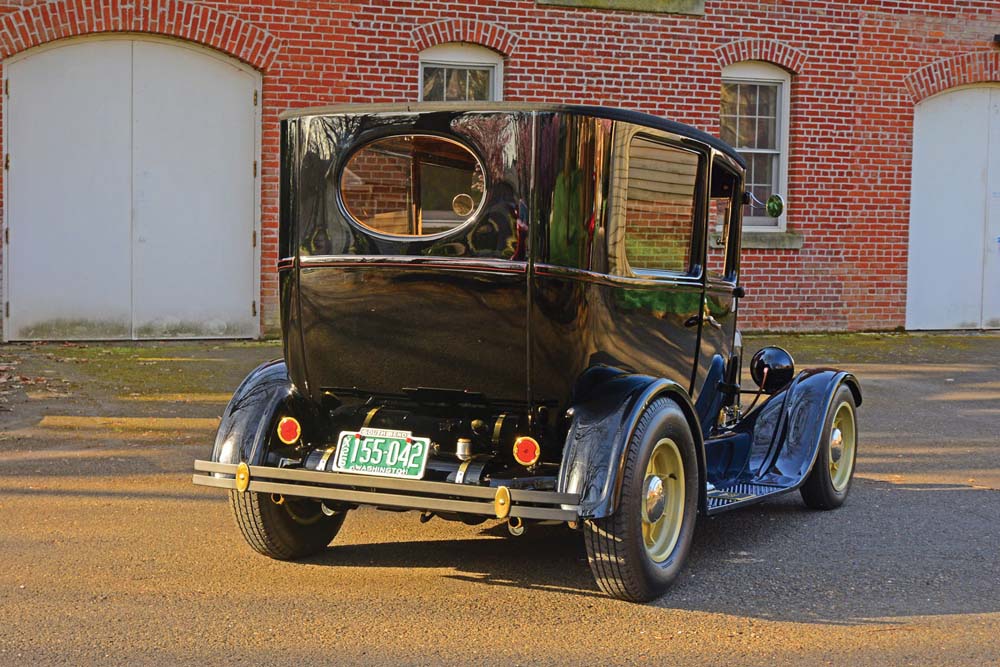By Dale Moreau – Photography By The Author
When is the last time you saw a hot rod Model T sedan? For most, it might be Lil’ John Buttera’s beer bottle brown ride on the September 1974 cover of Hot Rod. Nothing else since has come close to that—until now.
After finding a fairly good 1926 Ford Tudor sedan a few clicks from his home, Dave Rocha and hot rod builder Brent Housley took the four-hour drive to pick up the parts. They found it was in great shape for its age and even included an original frame. The frame was used for reference points as the new homebuilt frame came together.
That frame for the 1926 Ford Tudor sedan is made up of 1-1/2×3-inch 0.125 wall and a 1-inch square lower framerail. The front X-member comes from Mad Max Creations (MMC) owned by Housley to drop the front 1-1/2 inches.
The rear is Z’d 4 inches and 1932 Ford framehorns with spreader bar are used to encase the 1923 Ford gas tank. Up front uses a Magnum 5-inch tube axle and steering arms, a five-leaf spring, 1940 Ford split wishbones, and Pete and Jakes tube shocks. Stopping happens with 1939 Lincoln brakes, Wilson Welding hubs, and Buick finned drums. A 1960 Edsel gave up its 3:89:1 rear axle. Aldan coilovers and Speedway Motors torsion bars with 1975 Ford brake drums put it on the ground. A new Vega 400 13.6:1 power steering box with reservoir by MMC provides the steering.
Check Out: Installing a Universal Fuel Sending Unit and Fuel Tank – 1936 Ford Project
The engine was sourced from a 1985 Ford 302 V8 with its overdrive transmission and rear third member. Exhaust manifolds are both left hand Falcon sprint with a custom exhaust. A beautiful aluminum and brass custom air cleaner is an owner-built item. The Brassworks brass radiator is built with a 3-1/2-inch copper core.
Henry’s body now has a recessed firewall, wood-backed floor panels, tubbed rear wheel wells, and widened rear fenders by Kiwi Metal Fab. MMC then added the 1915 Center Door Model T rear window. The revamped sun visor has three vents to ease airflow against the tall car’s windshield. Final body and fender metal finish and alignment came from Kiwi Metal Fab in Vancouver, Washington. The beautiful paint of Raven Black was laid on by Mike “Early Times” Parsons, also of Vancouver.
Solid brass features made by the owner are hood hold downs and formed hood plates, gas tank straps, solid brass bumper mounting brackets for the stock bumpers, modified brass–era Franklin door handles, copper headlight wire tubes, a steel spoon pedal assembly, and hinge mirror brackets. The stock Model T Ford headlights are now filled with Halogen bulbs with the 1934 Ford tail lights having LED lights with brass doors.
Dave’s interior has the look of a coach built car of the era. It is upholstered in distressed Antique Whiskey and Aztec Black Buffalo leather by Jack Mayeaux’s studio in Tigard, Oregon. The exposed top of Ash and Mahogany and Jelutong back window garnish molding was all done by the owner, the dome light was crafted from 1915 Ford cowl lamp parts.
A modified 1936 Ford dash has Classic Instruments and Vintage Air installed in it. Up above is a custom header panel filled with map lights and a storage pocket. The custom steering column is owner built and topped with a restored original 1920 16-inch Ford Model T steering wheel spider with a Fordite wheel ring to give the feeling of a factory “special edition.” (Note: Fordite is the slag leftover in painting areas. As it built up it had to be removed because it hampered production. The pieces were used to make the steering wheel ring.)
Check Out: Ragtop Hot Rod Restoration: A Supercharged Flathead 1939 Ford Convertible
Classy is the word that describes the wheels that started as Rocket Fire as-cast 16×5. Russ Meeks, out of Portland, machined the outers and then added a translucent ceramic finish with a gold tint. For a ’20s factory look, Marv Norton machined mounting rings to retrofit 1934 Ford four-cylinder caps matching the design of the oval rear window.
The wheels are wrapped with the Excelsior Stahl Sport Radial 500r 16 on the front and 700r 16 on the rear.
It is very refreshing to see Dave’s perception and creativity on a body style hardly seen since the ’70s as a basis for a hot rod project. With so many wannabes these days, it’s very unusual to see this kind of design and quality from the 1926 Ford Tudor sedan from the Model T era. It’s my guess that you haven’t seen the last of this one.









































